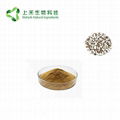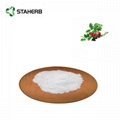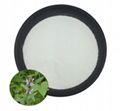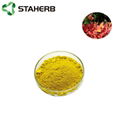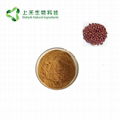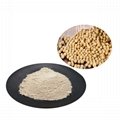| Model: | - |
|---|---|
| Brand: | Changsha Staherb |
| Origin: | - |
| Category: | Agriculture & Foods / Agricultural Products & Resources / Plant Extract |
| Label: | - |
Tea tree mushroom extract uses and synthesis methods of plant extracts Tea tree mushroom extract is the aqueous or alcoholic extract of tea tree mushroom, which has strong antioxidant capacity, and tea tree mushroom extract has good development prospects as a natural antioxidant. Tea tree mushroom (Agrogcybecylindracea), also known as poplar mushroom, tea salary mushroom, willow pine mushroom, etc., belongs to the genus Tianmus in the family of dunghyacae and is rich in amino acids and trace elements needed by human body and contains polysaccharides with anti-cancer activity. It has a delicious taste, nourishes yang and strengthens yin, and has a unique effect on kidney deficiency, frequent urination, edema, rheumatism, and has ideal therapeutic functions for anti-cancer, hypotension, pediatric hypothermia, bedwetting, and is known as "sacred mushroom". Resource distribution Tea tree mushroom is a woody edible fungus that grows from spring to autumn in temperate to subtropical regions, mainly in temperate regions of Asia, Europe and southeastern North America. It is mainly produced in Shanxi, Jiangsu, Zhejiang, Fujian, Taiwan, Guangdong, Hainan, Yunnan, Guizhou, Sichuan, Tibet, Qinghai and other places. It grows naturally in spring and autumn on dead trunks and decaying stumps of broad-leaved trees such as poplar, willow, maple, ficus, Ficus microcarpa and roots buried in the soil. Plant morphology Tea tree mushroom is continuous or clustered, with hemispherical to flattened cap, slightly protruding in the middle, smooth surface, dark reddish-brown when young, then gradually turning brown or light earthy brown, with light brown edges and shallow wrinkles. The flesh of the mushroom is dirty white, thicker in the middle and thinner at the edge. Folds white, later become coffee-colored, dense, straight, unequal. Stalk down gradually light brown, with small ciliate scales, solid to flaccid, more curved and slightly twisted, brittle. The ring is membranous, light white, with fine stripes on the surface, born in the upper part of the mushroom stalk, often brown because it is covered with spores. Spore print rusty brown, spores oval, 8.5-11μm×5.5-7μm, bud pore inconspicuous, marginal vesicle 19-30μm×5.5-7μm. mycelium colorless, with lock-like union. Figure 1 shows the chemical composition of tea tree mushroom. 7.91% of total water, 16.14% ash, 29.51% protein, 0.16% crude fat, 0.06% crude fiber, 46.22% carbohydrates, mainly carbohydrates and proteins. 1. amino acids amino acid components and content in tea tree mushroom are aspartic acid 2.903, glutamic acid 5.148, serine 1.287, histidine 0.5552, glycine 1.117, arginine 1.921, alanine 1.461, tyrosine 0.4221, cysteine 0.08441, jessamine* 0.9369, methionine* 0.1815, phenylalanine* 0.5589, isoleucine* 0.5452, leucine* 0.7481, lysine* 1.867, proline* 0.867, and lysine* 0.867. 1.867, proline 0.6773 in g/100g (with * as essential amino acid for human body). There are 17 kinds of amino acids that make up the protein in tea tree mushroom, and the essential amino acids account for 27.94% of the total free amino acids. The high content of these amino acids gives the mushroom a fresh taste and high nutritional value.2. Minerals The analysis results of trace elements in the mushroom showed that Zn79.3, Fe79.2, Cu18.9, Mn25.2, Mg3021, Ca3607, As0.41, Pb0.91, in μg/g, the content of beneficial elements is considerable. Trace elements are the active factors of many enzymes, involved in protein synthesis and regulation of human metabolism, and also have the functions of constituting bones, hemoglobin, cytochrome, maintaining osmotic pressure and acid-base balance in living organisms. Tea tree mushroom contains many mineral elements, among which calcium and magnesium are high, iron is suitable for people with iron deficiency anemia and low blood sugar, and lead and arsenic are low in harmful heavy metal elements. 3. Volatile substances The volatile substances in tea tree mushroom are as many as 52 kinds by GCMS, including many organic acids, alcohols, ketones, phenols, aldehydes, esters, etc. These volatile components are of a wide variety. Polysaccharides and monosaccharides The sugars in tea tree mushroom are mainly composed of glucose, followed by galactose, arabinose, xylose and mannitol. The main composition and mass fraction of monosaccharides in intracellular polysaccharide and extracellular polysaccharide of tea tree mushroom were 0.74% and 1.10% for arabinose, 1.41% and 0.62% for xylose, 0.96% and 1.30% for mannitol, 22.3% and 26.3% for glucose, and 2.97% and 3.15% for galactose. The results of polysaccharide content determination showed that the intracellular crude polysaccharide content was 11.2%, and the polysaccharide content in extracellular crude polysaccharide was 20.3%, which was higher than other mushrooms. The resource distribution, plant form, chemical composition, and pharmacological effects about Tea tree mushroom extract were compiled by Squire Yan of Chemicalbook. (2015-09-24) Pharmacological activity 1. Antioxidant activity Tea tree mushroom extract has a strong antioxidant capacity. Active oxygen free radicals can cause aging, cancer, immune deficiency syndrome and many other diseases, seeking natural and efficient oxygen free radical scavengers to inhibit the damage caused by oxygen free radicals to the organism has received much attention. The toxicity of superoxide radicals is the main cause of oxygen toxicity in the organism, which can cause changes such as genetic mutation membrane damage enzyme system failure and mitochondrial oxidative phosphorylation. ROO is ethanol in alkaline aerobic, photolysed to CH(OH)CH under strong UV irradiation, which is a free radical initiator acting directly on linoleic OH is the most active free radical, the most toxic, and can react with any molecule in living cells to cause damage, and the free radical chain reaction can cause damage to organisms in a wide range. After the determination of the effect of O, OH and ROO scavenging, tea tree mushroom extract confirmed that tea tree mushroom extract has strong antioxidant capacity, and the scavenging capacity increased continuously with the increase of mass concentration in a certain concentration range, up to 69.29%, 90.26% and 63.59% respectively. Tea tree mushroom can be a promising fungus for the extraction of pure natural antioxidants.2. Immunomodulatory function Tea tree mushroom extract has the functions of clearing heat, calming the liver, brightening the eyes, diuretic and strengthening the spleen. Its can improve the immune function, this immune modulating effect is mainly due to its polysaccharide, fungal polysaccharide as a wide source, low toxicity, less toxic side effects and strong immune macromolecule has received wide attention. It can be extracted from the dried seeds of A. chinensis and purified to obtain A. chinensis polysaccharide (ACPS), which is a protein-free, acidic polysaccharide composed of galactose and rhamnose and galacturonic acid, and can significantly increase the phagocytic efficiency and phagocytic index of normal mouse macrophages, and has an activating effect on macrophages, which have important biological roles, not only in non-specific immune defense 3. Hypertension is a serious health hazard, often accompanied by morbidity, and can cause myocardial hypertrophy, heart failure, cardiac pain and myocardial infarction, long-term hypertension can also cause ventricular dilatation, resulting in hypertensive heart disease, leading to stroke, cerebral infarction and cerebral hemorrhage, and can cause renal arteriosclerosis, leading to uremia. ACE inhibitory peptides (AngiotensinConvertingEnzymeInhibitoryPeptides) are small molecule peptides that are obtained by protein hydrolysis enzymes under mild conditions and are safe for consumption. It has no hypotensive effect on people with normal blood pressure, and has immune promoting effect, can lose weight, easy to digest and absorb. The ACE inhibitory peptide isolated from tea tree mushroom has strong inhibitory activity in in vitro test, and the effect of lowering blood pressure in animal test and human clinical test is also obvious, and the consumption of tea tree mushroom has the effect of regulating blood lipid, lowering blood sugar and blood pressure.4. Anti-tumor effect Tea tree mushroom extract has important gene Aa-Pri, which encodes tea tree mushroom hemolysin These proteins can interact with lipid membranes, have hemolytic activity, can permeabilize lipid vesicles and bind to serum lipoproteins, have cytotoxic activity, and have anti-cancer, anti-malignant cell proliferation and anti-bacterial activity properties. The anticancer lectin (AAL) in tea tree mushroom can act as an anticancer agent by inducing apoptosis and exerting DNase activity. It was found that tea tree mushroom extract could promote the differentiation and proliferation of T cells, enhance the delayed hypersensitivity response involved in T cells, and have a significant inhibitory effect on tumors. The tumor weight inhibition rate of tea tree mushroom extract was 29.9% for S180 transplanted sarcoma in mice, 22.7% for the weight gain ratio of S180 ascites tumor-bearing mice, and 32.2% for the division index of S180 ascites tumor cells.
Company Introduction
Address: Room 202, Building B8, Huanchuang Enterprise Square, Lugu Street, Yuelu District, Changsha City, Hunan Province
Website: http://www.staherb.com/
Business scope: Biotechnology, research and development of plant extracts (can be used in the field of pharmaceutical and health products, cosmetics, feed additives and biological pesticide production and development)
Main products: Eucommia extract - chlorogenic acid (5%-98%), ursolic acid (25%-98%), corosolic acid (1%-98%), bitter amygdalin (50%-98%), epimedoside (10%-98%) and other standardized high-purity plant extracts.
If you wanna know more about us, please feel free to contact me at:
Whatsapp: +86 13548561509
Email: staherb18@staherb.cn
or you can send me online message if it's convenient for you.
We look forward to cooperating with you!

